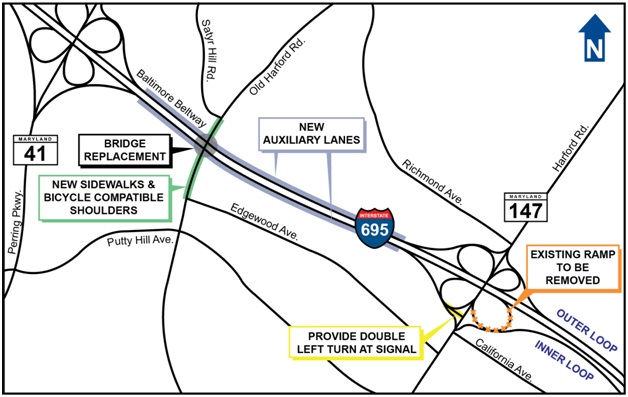BALTIMORE, Md. (October 17, 2014) – Motorists traveling along I-695 (Baltimore Beltway), between MD 147 (Harford Road) and MD 41 (Perring Parkway), will soon enjoy the benefits of a safer commute thanks to the Transportation Infrastructure Investment Act. Delivering on their commitment to improve travel and enhance traffic safety to meet the transportation needs of communities throughout Maryland, Governor Martin O’Malley and Lt. Governor Anthony G. Brown today announced the start of work to widen and improve this heavily-travelled stretch of road in Baltimore County. Work on the $34.4 million project, made possible thanks to funding from the Transportation Act, began this week and is scheduled to be complete in summer 2017, weather permitting.
“Thanks to the Transportation Act, we are putting people back to work building and upgrading our roads, bridges and tunnels in every corner of our State,” said Governor O’Malley. “The Baltimore Beltway is an integral part of our regional economy. By making investments in safety upgrades now we will ensure that we keep more Marylanders safe, while also strengthening and growing our middle class.”
“By making investments in our infrastructure and improving the safety of our roadways, we’re creating jobs, growing our economy and improving the quality of life for more Marylanders,” said Lt. Governor Brown. “Thanks to this safety project, thousands of motorists who rely on the Baltimore Beltway each day will be able to navigate this congested section of highway both safely and easily.”
The project includes widening and resurfacing approximately one mile of the inner and outer loops of I-695 to provide continuous auxiliary lanes between MD 147 and MD 41. The auxiliary lanes - separate lanes that allow motorists to exit/enter a roadway at designated areas - will improve traffic safety by minimizing the maneuvering/weaving of traffic. Currently, 160,825 vehicles travel this section of I-695 each day, with traffic projected to increase to 181,275 vehicles per day by 2030.
The safety project also includes removing the “cloverleaf” ramp from eastbound I-695 (inner loop) to northbound MD 147 and replacing this traffic movement by widening and adding left turn lanes at the end of the existing ramp from eastbound I-695 to southbound MD 147. Additionally, crews will replace the existing Old Harford Road Bridge over I-695. The new two-lane bridge will carry two through lanes, one left turn lane, shoulders and sidewalks on both sides.
Other related work includes: improvements to the median on Harford Road and the signal at the intersection of Harford Road and the ramp from westbound I-695 (outer loop); highway drainage and storm water management improvements along I-695; installation of new overhead lighting at both interchanges; reforestation along I-695 and landscaping treatments for the beautification of I-695, Old Harford Road and the Harford Road interchange.
During the project, motorists should anticipate temporary lane closures during off-peak hours -- weekdays between 9 a.m. and 3 p.m. and weeknights between 8 p.m. and 5 a.m. There will be temporary lane and ramp closures throughout the duration of the project. The first phase of construction involves widening eastbound and westbound I-695 (inner and outer loops) and removing and replacing the Old Harford Road Bridge over I-695. The Old Harford Road Bridge will remain open to all traffic during construction. The second phase of work includes widening the ramp from eastbound I-695 (inner loop) to southbound Harford Road, installing a new traffic signal at the end of the ramp, and closing the ramp from eastbound I-695 to northbound Harford Road. The Six-M Company of Delta, Pa., was awarded the construction contract.
While SHA and its partners work hard to maintain safe traffic mobility in work zones, each driver needs to actively modify his or her driving style to help prevent crashes. Stay alert – look for reduced speed limits, narrow driving lanes and highway workers. Slow down and don't follow too closely. Safer Driving. Safer Work Zones. For everyone!
###

Project Map